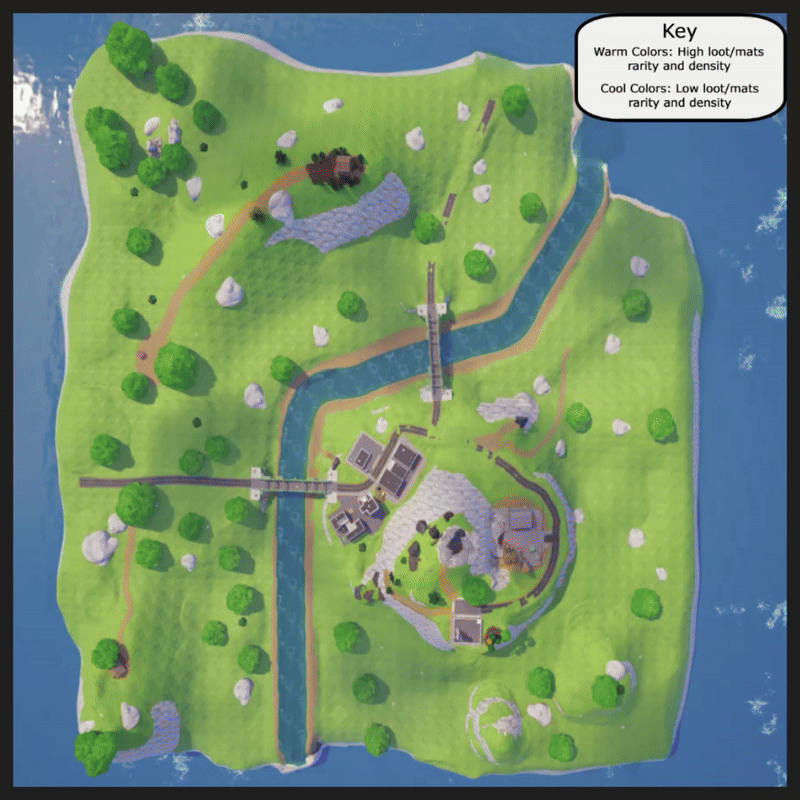Chaotic Cavern (POI)
Type of Project: Personal Solo | Role: Level Designer | Size: Independent | Duration: 7 weeks | Year Created: Early 2025 | Software: UEFN, Fortnite Creative
Overview
Battle Royale POI Design
Designed a POI to seamlessly integrate with past Fortnite maps while providing a new and enriching player experience.
Applied single-player guidance principles, architectural design, and competitive multiplayer space design to create a visually appealing, balanced, and easily navigable location.
Expanded design skills by crafting a large-scale POI with multiple interconnected locations.
Work Summary
Made a significant design pivot to strengthen player experience and reinforce the POI’s thematic identity.
Designed traversal options to address the challenges of a large POI and maintain satisfying player movement.
Used ambient storytelling through prop placement, landmarks, buildings, and lighting to enhance immersion.
Planning & Research
I studied Fortnite POIs to inspire me and align Chaotic Cavern with Fortnite’s level design philosophy. POIs including:
Retail Row
Slappy Shores
Shifty Shafts
The Grotto
Studied lane structures to inform my own layout design.
Developed a top-down layout based on research findings.
Gathered feedback from peers and professors before moving forward.
Project Pitch and Planning Documents
©Fortnite. (2020) . Epic Games
Location Design and Player Traversal
Balanced loot distribution by concentrating high-tier loot in the central cavern, making it a high-risk, high-reward hot drop, while decreasing rarity and density in outer areas.
Designed three primary areas (Retail, Cavern, Radio Station) to support a 20-player lobby, ensuring dynamic combat and looting opportunities.
Developed a central hub interconnected by cave systems and zip lines for fluid movement.
Crafted locations using the modular kit that accommodates and rewards different playstyles.
Environmental Storytelling
Used loot placement and props to draw players into the location’s narrative.
Utilized buildings to inform players about the POI's origins and the cavern's mystery.
Set dressed interior and exterior spaces to convey the POI’s story.
Placed the most visually interesting areas in high-loot zones to encourage exploration.
POI Pivot and Refinement
Problems:
The initial POI design lacked uniqueness and depth.
The central pit was not visible from a distance, reducing its impact.
Traversal to the cavern/pit felt uninteresting.
The lack of verticality made the POI visually and gameplay-wise unappealing.
Original POI
Early Version Of Current POI
Solutions:
Transformed the pit into a hollowed-out mountain for greater visibility from the Battle Bus and ground level.
Created distinct terraces (retail/suburbs, mining, cavern, radio station) to make the POI approachable from all sides.
Added tunnels, zip lines, and porta-potty teleports for fluid traversal to support the verticality of the new POI design.
Designed the cavern area as a parkour-friendly space to encourage movement-based gameplay.
Ending Notes
Learning Outcomes
I found with this project that playing it safe doesn’t foster creativity and makes levels lack an identity. Throughout building this space, I realized I was trying to do what I thought was safe and would be ‘guaranteed’ to work. I wanted to design a POI where I could lean more into the research of previously made spaces since the POI previously closely followed the layout of Retail Row.
With that realization, I realized my driving force was not wanting to mess up the feeling of a POI. It then pushed me to think of ideas with a stronger identity that could set themselves apart from previous POIs and be recognizable. Though it was my first time building a custom Fortnite POI I knew that if I wanted to make something that would stand out I needed to trust my intuition, do my research, and create something that would stand out.
Complications/Issues
I hit a creative roadblock early in this project. After giving my level pitch to fellow students and professors, I got a lot of approval for this idea. When I started work, I would sit down and not know what to do. The vision of the POI wasn’t there, and every time I worked on it, I felt that something was off, which slowed down my process heavily. I met with mentors and peers to get ideas and finally found the solution. I looked for help from others to solve this problem, and I found a new, bolder path to take with the project.
Creative roadblocks are a problem every developer and human faces. Though it was an issue at first, once I caught my stride, I built something I knew I could be proud of.





